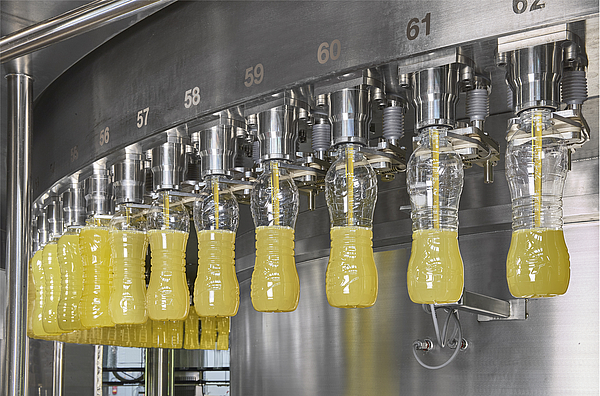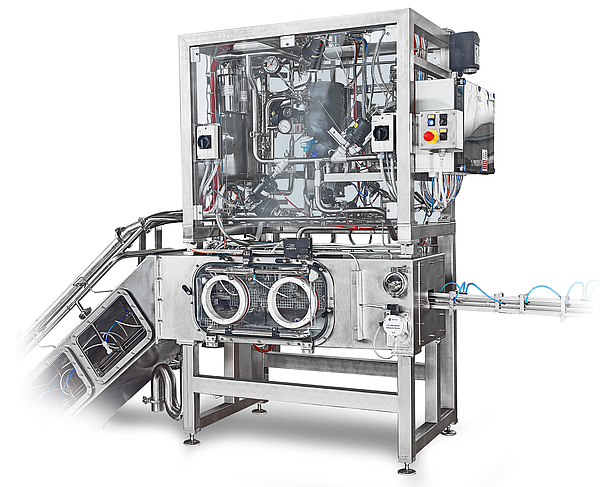

How to provide the flexibility beverage manufacturers need for today’s demanding consumers
The only constant in the beverage market is change: fashions come and go, new markets develop, consumers become more demanding. Opportunities arise for manufacturers, some of which are exploited creating the profit and energy needed for businesses to thrive, while other are missed. In this article GEA, looks at how the development of aseptic dual fill technology is providing the flexibility manufacturers need with the quality consumers demand in an increasingly buoyant and diverse marketplace.
The worldwide beverage market is forecast to grow to USD 1.9 trillion by 2021. That’s an impressive figure but for many manufacturers it’s not the total volume of drinks sold that matters, it’s the diversity that’s key. Today’s discerning consumers are looking for variety and quality, so manufacturers need to have the ability to create a wide range of high quality beverages as efficiently as possible.
One trend that has been building in recent years, especially in Asian markets, is the demand for beverages that include solid pieces such as fruit, fibers, and cereals, which turn what would otherwise be just a refreshing drink, intended simply to quench the thirst, into a meal replacement. This can include the addition of coconut, nuts, aloe vera pieces, even berries to make exciting foods that are perceived as being of higher quality than liquids alone or, with the inclusion of fruit pulps and fibers, mimic more faithfully freshly-squeezed juice. These additions create a product that achieves a more constant glycemic curve, not just a peak typical of simple sugars.
FILLING TECHNOLOGY FOR LIQUIDS AND SOLIDS
To achieve the quality and variety demanded by consumers, GEA believes that a filling system needs to be both dual fill and aseptic: Dual fill technology adds the pieces of fruit or fiber in a separate process from the liquid beverage very accurately using a piston doser. This is very difficult to achieve in a single stream process as the solid product tends to settle and separate from the liquid phase within the system. Keeping the product in a constant state of agitation to maintain the homogeneity is likely to cause product stress and loss of quality. Kept in suspension in this way pieces can also bridge with each other and clog making them hard to process. Dual fill technology is a consolidated, but GEA believes that it was the first manufacturer to supply dual fill technology as part of an aseptic, cold fill process.
Aseptic filling does not require the application of heat at the filling stage. Pasteurization of the liquid and solid streams takes place separately, upstream, so can be tailored precisely to the individual product requirements. This has significant advantages: it extends shelf life without the use of preservatives; there is much less thermal stress on the product, so it retains much more of its natural nutritional value, taste and color; and the PET bottle itself can be much lighter, saving materials, reducing manufacturing costs, and limiting the impact on the environment.
THE DUAL FILL, ASEPTIC PROCESS
As with all aseptic processes dual fill bottling takes place within a controlled microbiological environment that maintains sterility throughout the process.
UPSTREAM
Solid ingredients are usually delivered either as a compote in a carrier fluid or in chunks. If ingredients are delivered dry, they need to be mixed with a carrier liquid before pasteurization. Liquid components are often prepared beforehand by deaeration, the addition of ascorbic or citric acid, or homogenization.
Solid pieces require a significantly longer pasteurization time than liquids to ensure that the correct temperature is achieved right through to the core. Treatment temperature and time depend on the texture and size of the solid pieces.
For a long shelf life, microorganisms – including dormant spores – must be killed or inactivated. For fruit juices, pasteurization at a minimum temperature of 85° Celsius for 20 to 30 seconds is ideal. Less acidic liquids, such as vegetable juices, need to be heated to higher temperatures. Both solid and liquid ingredients pass through aseptic balance tanks before filling. This prevents re-contamination and avoids the need for further pasteurization when an ingredient waits in line.

Fig. 2: GEA Fillstar CX EVO for the aseptic soft drink bottling without changeover time on one machine.? (Photo: GEA)
DUAL FILLING
The GEA dual fill, aseptic filling process then brings these two elements together in the correct proportion in accordance with the recipe. The process can be used for filling a wide range of beverages including high and low acid, still or sparkling, with pieces of fruit or cereals up to 10 x 10 x 10mm. The dosing valve, the GEA Piston Doser PX, uses a highly accurate, cam-driven piston to first draw the prescribed volume of solid particles into the cylinder, before injecting it into the awaiting PET bottle. The bottle then moves onto a standard volumetric, electronic filler to add the liquid juice and complete the aseptic filling process.
ASEPTIC INTEGRITY
The aseptic integrity of the piston doser is maintained with the inclusion of a hygienic seal around the piston which prevents product leaking through to the non-aseptic side. Dosing volume can easily be regulated from 15 to 150 ml by changing the dosing value on the HMI (Human Machine Interface). The stroke of the piston is automatically adjusted by a linear motor. This provides adequate dosing for most products in PET bottles of up to two liters. Smaller or Greater dosing volumes may be achieved simply by changing the diameter of the cylinder.
The technology complies with the most stringent microbiological validation protocol specifications worldwide, including Europe, Far East and the USA. All sanitation and sterilization cycles are automatically controlled in all critical points. The system has a small footprint and can maintain a production level of over 50,000 bottles per hour (bph).
A NEW FILLSTAR GENERATION
The Fillstar CX EVO is the latest generation of aseptic filling technology for the liquid phase. This multi-functional system provides beverage industry customers with the capacity to seamlessly switch between different types of products, from carbonated to still aseptic beverages and vice-versa. Product changeover times are significantly reduced as the integrated control unit merely requires reprogramming. The changeover from contact filling to non-contact filling is fully automated without the system sterility being compromised.
The new technology uses a counter-pressure, volumetric electronic filling valve. GEA engineers have refined the tried and tested filling technology for carbonated beverages, making it suitable for a wide range of applications – the Fillstar CX EVO can handle high and low acid beverages, as well as aseptic soft drinks with varying carbonation levels, to ensure complete sterility. It can fill products with fibers up to 20 mm long and with diameters of 3 mm itself; when integrated with an aseptic piston doser the system can fill fruit pieces with a volume of up to 10x10x10 mm. Bottle sizes and shapes – which is just as important for producers to attract consumers’ attention – can be easily changed.

Fig. 3: GEA’s Aseptic Blow Fill (ABF) solution, equipped with an H2O2 sterilization system for aluminum foil closure and suitable for high and low acid drinks, which offers a safe, flexible and aseptic way to fill plastic bottles. New GEA Sterilfoil VHP L is developed for foil sterilization (Photo: GEA)
THE ABC OF ABF
The GEA aseptic dual filling process can be applied to any beverage filling platform but achieves its maximum flexibility when working as part of an Aseptic Blow Filling (ABF) line. The principle is to sterilize the preforms, not the bottles, with Hydrogen Peroxide at the exit of the oven. The bottles are then blown using sterile air in a sterile environment; this sterility is maintained throughout the filling and capping process.
Sterilizing the preform instead of the bottle reduces the quantity of sterilizing agent used as the preform is smaller and a more simple shape than the bottle itself. As the preform is made of thicker material than the bottle itself it’s possible to increase the temperature of the treatment without risk of shrinkage that would affect the shape of the bottle. This allows the weight of the bottle to be kept to an absolute minimum. ABF minimizes the use of chemicals, requires no bottle rinsing, enables a simpler and smaller layout and reduces energy consumption.
This innovation from GEA also has the benefit of allowing manufacturers to experiment more creatively with bottle designs to make them more ergonomically and visually attractive helping them to attract greater attention on retailers‘ shelves.
CAPPING
At the end of the filling cycle, the containers must be sealed before exiting the controlled environment to avoid recontamination. Cappers are, therefore, integrated into the microbiological isolator and specifically designed for aseptic applications. Aseptic dual fill technology can be used with the entire range of GEA filling/capping systems including GEA’s new Sterilfoil VHP L closure system launched at Drinktec last year.
ULTIMATE FLEXIBILITY
The result of combining dual fill with aseptic production is the most flexible PET bottle filling system available. It has the ability to fill a wide range of drinks, including complex liquid foods such as yoghurt, liquid breakfasts and juices that contain pieces of fruit and fiber - high and low acid, still and carbonated. It’s filling accuracy is exceptionally high and different products can be run on the same machine. Automatic sterilization-in-place (SIP) using overheated water, allows fast product changeover yet eliminates any chance of cross contamination. This flexibility not only allows manufacturers to produce a wide range of beverages it also allows for efficient experimentation to develop new products and bring them to market quickly and profitably thereby taking advantage of marketing opportunities as they arise.

Fig. 4: Sterilfoil VHP L is an integrated aseptic system for closing HDPE bottles with aluminum foil. (Photo: GEA)
FLEXIBILITY FOR EFFICIENT PRODUCTION
The market is increasingly demanding the multi-functionality that aseptic dual fill technology can provide. Since its introduction by GEA in 2014 beverage manufacturers in Europe, the USA and the Far East have adopted the technology taking full advantage of the opportunities it provides to develop high quality food products in bottles that are healthy and can be enjoyed by busy people everywhere. Right now, GEA has six new systems in production for delivery in the next few months giving testimony to its popularity.
Worldwide manufacturers today need flexible systems that can produce a wide range of excellent quality products, with or without pieces, that taste good, are nutritious, look attractive and are produced in a highly efficient, environmentally sustainable way. Aseptic dual fill from GEA ticks all the boxes.
The comPETence center provides your organisation with a dynamic, cost effective way to promote your products and services.

magazine
Find our premium articles, interviews, reports and more
in 3 issues in 2026.




